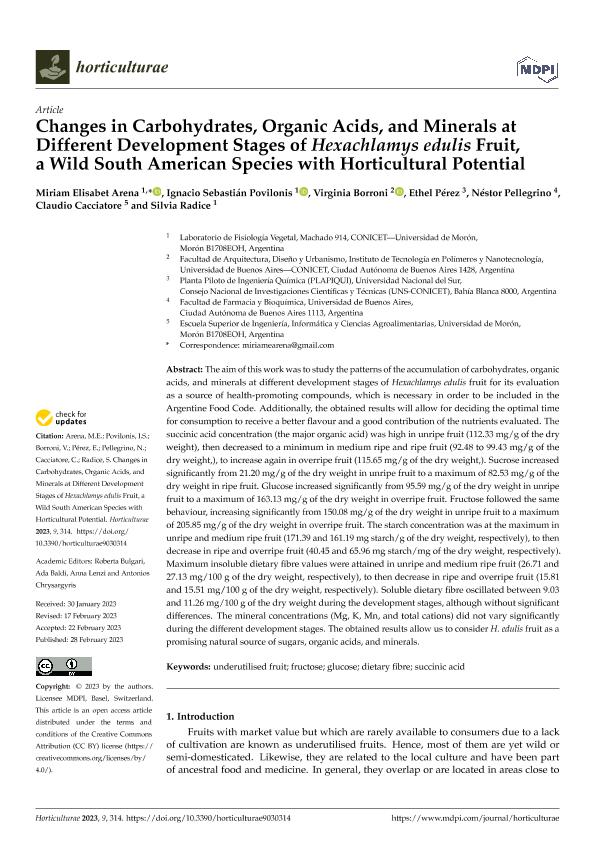Artículo
Changes in Carbohydrates, Organic Acids, and Minerals at Different Development Stages of Hexachlamys edulis Fruit, a Wild South American Species with Horticultural Potential
Arena, Miriam Elisabet ; Povilonis, Ignacio
; Povilonis, Ignacio ; Borroni, Maria Virginia
; Borroni, Maria Virginia ; Perez, Ethel
; Perez, Ethel ; Pellegrino, Nestor; Cacciatore, Luis Claudio; Radice, Silvia
; Pellegrino, Nestor; Cacciatore, Luis Claudio; Radice, Silvia
 ; Povilonis, Ignacio
; Povilonis, Ignacio ; Borroni, Maria Virginia
; Borroni, Maria Virginia ; Perez, Ethel
; Perez, Ethel ; Pellegrino, Nestor; Cacciatore, Luis Claudio; Radice, Silvia
; Pellegrino, Nestor; Cacciatore, Luis Claudio; Radice, Silvia
Fecha de publicación:
02/2023
Editorial:
Multidisciplinary Digital Publishing Institute
Revista:
Horticulturae
e-ISSN:
2311-7524
Idioma:
Inglés
Tipo de recurso:
Artículo publicado
Clasificación temática:
Resumen
The aim of this work was to study the patterns of the accumulation of carbohydrates, organic acids, and minerals at different development stages of Hexachlamys edulis fruit for its evaluation as a source of health-promoting compounds, which is necessary in order to be included in the Argentine Food Code. Additionally, the obtained results will allow for deciding the optimal time for consumption to receive a better flavour and a good contribution of the nutrients evaluated. The succinic acid concentration (the major organic acid) was high in unripe fruit (112.33 mg/g of the dry weight), then decreased to a minimum in medium ripe and ripe fruit (92.48 to 99.43 mg/g of the dry weight,), to increase again in overripe fruit (115.65 mg/g of the dry weight,). Sucrose increased significantly from 21.20 mg/g of the dry weight in unripe fruit to a maximum of 82.53 mg/g of the dry weight in ripe fruit. Glucose increased significantly from 95.59 mg/g of the dry weight in unripe fruit to a maximum of 163.13 mg/g of the dry weight in overripe fruit. Fructose followed the same behaviour, increasing significantly from 150.08 mg/g of the dry weight in unripe fruit to a maximum of 205.85 mg/g of the dry weight in overripe fruit. The starch concentration was at the maximum in unripe and medium ripe fruit (171.39 and 161.19 mg starch/g of the dry weight, respectively), to then decrease in ripe and overripe fruit (40.45 and 65.96 mg starch/mg of the dry weight, respectively). Maximum insoluble dietary fibre values were attained in unripe and medium ripe fruit (26.71 and 27.13 mg/100 g of the dry weight, respectively), to then decrease in ripe and overripe fruit (15.81 and 15.51 mg/100 g of the dry weight, respectively). Soluble dietary fibre oscillated between 9.03 and 11.26 mg/100 g of the dry weight during the development stages, although without significant differences. The mineral concentrations (Mg, K, Mn, and total cations) did not vary significantly during the different development stages. The obtained results allow us to consider H. edulis fruit as a promising natural source of sugars, organic acids, and minerals.
Palabras clave:
DIETARY FIBRE
,
FRUCTOSE
,
GLUCOSE
,
SUCCINIC ACID
,
UNDERUTILISED FRUIT
Archivos asociados
Licencia
Identificadores
Colecciones
Articulos(ITPN)
Articulos de INSTITUTO DE TECNOLOGIA EN POLIMEROS Y NANOTECNOLOGIA
Articulos de INSTITUTO DE TECNOLOGIA EN POLIMEROS Y NANOTECNOLOGIA
Articulos(PLAPIQUI)
Articulos de PLANTA PILOTO DE INGENIERIA QUIMICA (I)
Articulos de PLANTA PILOTO DE INGENIERIA QUIMICA (I)
Articulos(SEDE CENTRAL)
Articulos de SEDE CENTRAL
Articulos de SEDE CENTRAL
Citación
Arena, Miriam Elisabet; Povilonis, Ignacio; Borroni, Maria Virginia; Perez, Ethel; Pellegrino, Nestor; et al.; Changes in Carbohydrates, Organic Acids, and Minerals at Different Development Stages of Hexachlamys edulis Fruit, a Wild South American Species with Horticultural Potential; Multidisciplinary Digital Publishing Institute; Horticulturae; 9; 3; 2-2023; 1-11
Compartir
Altmétricas



